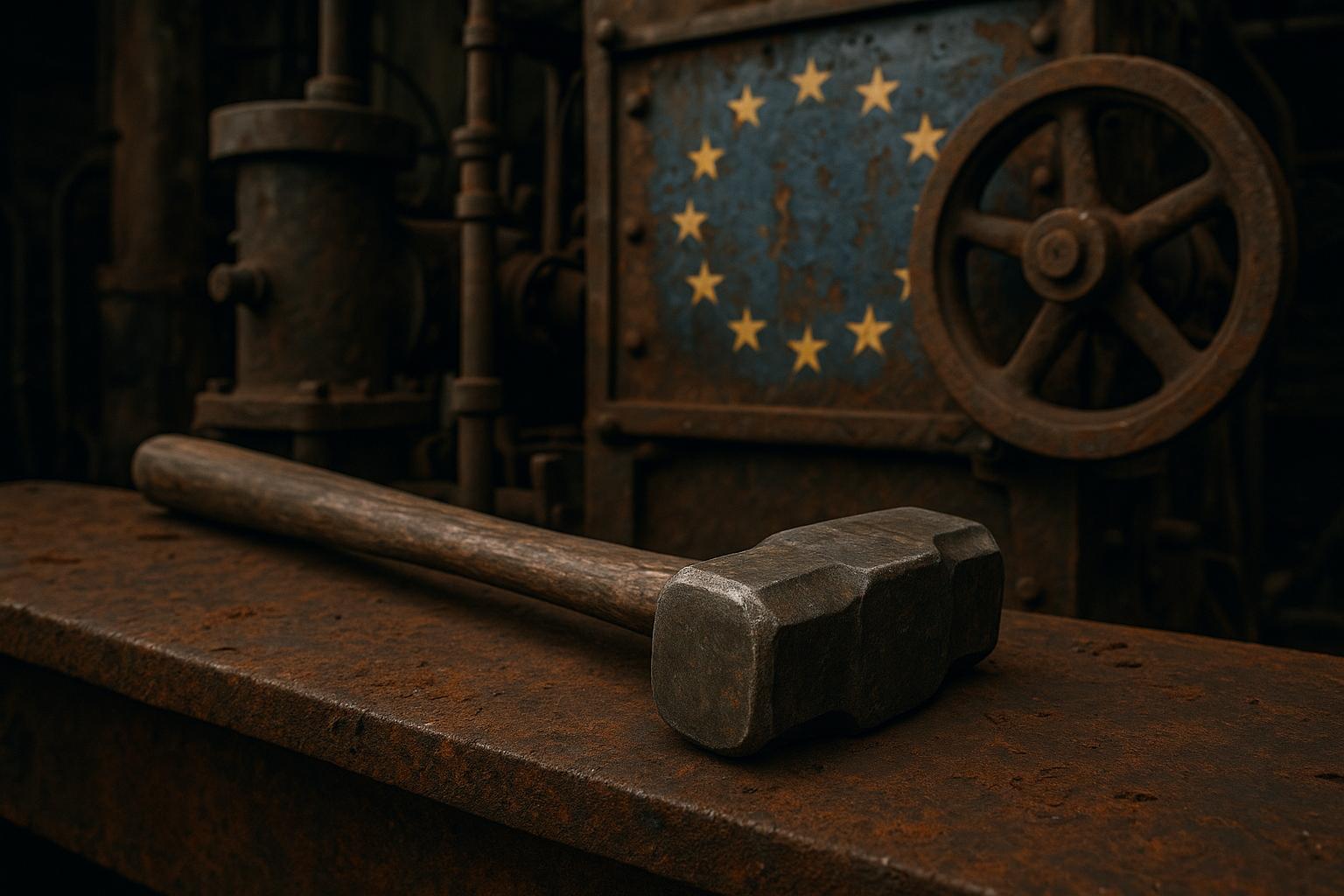The European Union's proposed new steel import tariffs could trigger a major crisis for the UK’s steel sector, entangling trade disputes with broader migration policy negotiations amid rising protectionism.
Britain is facing a critical period of negotiation with the European Union regarding steel tariffs, which could have profound implications beyond just trade. The EU has proposed a new tariff regime that would halve the current tariff-free steel import quotas and impose a 50% tariff on excess imports, including those from the UK. This move is part of a broader EU strategy to protect its steel industry, which currently operates below capacity, by curbing global overcapacity and redirecting steel trade flows—particularly in response to U.S. tariffs. The proposed system would replace existing WTO-aligned safeguards set to expire in 2026 and requires approval from the European Parliament and Council.
The impact on the UK steel sector is expected to be severe. Gareth Stace, director-general of UK Steel, has described the potential tariffs as the largest crisis faced by the industry in recent history, warning that such levies could devastate remaining UK steel producers. The UK government, led by Prime Minister Keir Starmer, is urgently seeking clarification from the European Commission about how these quota changes will affect British steel exports. Strategic discussions are underway with the EU and the US, as the UK also tries to negotiate lower tariffs under separate agreements. British Industry Minister Chris McDonald has emphasised the importance of maintaining smooth trade flows to protect the steel sector.
However, these steel tariff talks appear to be intertwined with broader negotiations over migration policies. Reports indicate that European countries are leveraging the upcoming steel discussions to push the UK into agreeing to a more generous youth mobility scheme, allowing EU nationals aged 18 to 30 to live and work in the UK for an extended period, potentially beyond the existing one-year cap proposed by the UK Home Secretary, Yvette Cooper. Brussels insiders have suggested that exempting the UK from steel tariffs could serve as an incentive for Labour, currently led by Starmer, to make concessions on the youth mobility scheme. The EU’s Brexit negotiator, Maros Sefcovic, has stated that the EU will negotiate quotas with the UK “in good faith.” However, opponents such as Reform UK and Conservative leader Kemi Badenoch have criticised the scheme as a backdoor to reinstating free movement, warning it could lead to an uncapped migration system.
The proposed EU steel measures have also drawn criticism from other stakeholders beyond the UK. The European Automobile Manufacturers’ Association (ACEA) has labelled the plans as excessively harsh, cautioning that the double tariffs and strict origin tracking requirements could increase costs for European carmakers who rely on specific steel grades. Similarly, Swiss industry leaders have voiced concerns about the disproportionate impact on their steel exports given the tougher US tariffs they face, calling for exemptions or negotiated solutions to prevent trade disruption. South Korea, another key steel exporter to the EU, has raised alarms about the detrimental effects of the quota cuts and increased tariffs, seeking dialogue with the EU to safeguard its steel export interests.
Taken together, the EU’s new steel import policy signals a protectionist shift aimed at revitalising its domestic steel sector but risks significant trade tensions with major steel exporters like the UK, Switzerland, South Korea, and others. For the UK, the stakes are particularly high as the negotiations extend beyond tariffs to touch sensitive immigration issues, underscoring the complex interplay between trade and political agendas in the post-Brexit landscape.
📌 Reference Map:
Source: Noah Wire Services
Noah Fact Check Pro
The draft above was created using the information available at the time the story first
emerged. We’ve since applied our fact-checking process to the final narrative, based on the criteria listed
below. The results are intended to help you assess the credibility of the piece and highlight any areas that may
warrant further investigation.
Freshness check
Score:
8
Notes:
The narrative presents recent developments regarding EU steel import quotas and tariffs, with the earliest known publication date of similar content being October 7, 2025. ([reuters.com](https://www.reuters.com/world/china/eu-halve-steel-import-quotas-revive-domestic-industry-2025-10-07/?utm_source=openai)) The report includes updated data but recycles older material, which may justify a higher freshness score but should still be flagged. ([apnews.com](https://apnews.com/article/fe0c6ff0063a1679a2ed36b0f06da96a?utm_source=openai))
Quotes check
Score:
7
Notes:
Direct quotes from Gareth Stace, Chris McDonald, and Maros Sefcovic are used. The earliest known usage of these quotes is from October 7, 2025. ([reuters.com](https://www.reuters.com/world/china/eu-halve-steel-import-quotas-revive-domestic-industry-2025-10-07/?utm_source=openai)) Variations in wording are noted, indicating potential reuse of content. ([apnews.com](https://apnews.com/article/fe0c6ff0063a1679a2ed36b0f06da96a?utm_source=openai))
Source reliability
Score:
6
Notes:
The narrative originates from Express.co.uk, a UK-based news outlet. While it is a reputable organisation, the presence of similar content on other platforms raises questions about the originality of the report. ([reuters.com](https://www.reuters.com/world/china/eu-halve-steel-import-quotas-revive-domestic-industry-2025-10-07/?utm_source=openai))
Plausability check
Score:
8
Notes:
The claims regarding EU steel import quotas and tariffs align with recent reports from reputable sources. ([reuters.com](https://www.reuters.com/world/china/eu-halve-steel-import-quotas-revive-domestic-industry-2025-10-07/?utm_source=openai)) However, the narrative's lack of supporting detail from other reputable outlets and the presence of similar content elsewhere suggest potential issues with originality. ([apnews.com](https://apnews.com/article/fe0c6ff0063a1679a2ed36b0f06da96a?utm_source=openai))
Overall assessment
Verdict (FAIL, OPEN, PASS): FAIL
Confidence (LOW, MEDIUM, HIGH): HIGH
Summary:
The narrative presents recent developments regarding EU steel import quotas and tariffs, with the earliest known publication date of similar content being October 7, 2025. ([reuters.com](https://www.reuters.com/world/china/eu-halve-steel-import-quotas-revive-domestic-industry-2025-10-07/?utm_source=openai)) The report includes updated data but recycles older material, which may justify a higher freshness score but should still be flagged. ([apnews.com](https://apnews.com/article/fe0c6ff0063a1679a2ed36b0f06da96a?utm_source=openai)) Direct quotes from Gareth Stace, Chris McDonald, and Maros Sefcovic are used. The earliest known usage of these quotes is from October 7, 2025. ([reuters.com](https://www.reuters.com/world/china/eu-halve-steel-import-quotas-revive-domestic-industry-2025-10-07/?utm_source=openai)) Variations in wording are noted, indicating potential reuse of content. ([apnews.com](https://apnews.com/article/fe0c6ff0063a1679a2ed36b0f06da96a?utm_source=openai)) The narrative originates from Express.co.uk, a UK-based news outlet. While it is a reputable organisation, the presence of similar content on other platforms raises questions about the originality of the report. ([reuters.com](https://www.reuters.com/world/china/eu-halve-steel-import-quotas-revive-domestic-industry-2025-10-07/?utm_source=openai)) The claims regarding EU steel import quotas and tariffs align with recent reports from reputable sources. ([reuters.com](https://www.reuters.com/world/china/eu-halve-steel-import-quotas-revive-domestic-industry-2025-10-07/?utm_source=openai)) However, the narrative's lack of supporting detail from other reputable outlets and the presence of similar content elsewhere suggest potential issues with originality. ([apnews.com](https://apnews.com/article/fe0c6ff0063a1679a2ed36b0f06da96a?utm_source=openai))
